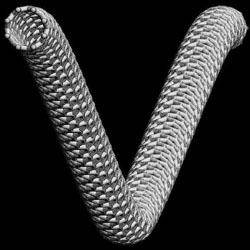Nanotubes Under Stress

Pressing on a carbon nanotube can change its electrical properties, according to research published in the 18 April PRL. The researchers experimentally confirmed what some theorists have predicted: Stretching a nanotube can either increase or decrease its conductivity–depending on the type of nanotube–by changing the structure of quantum states available to electrons. The results could someday allow physicists to build nanotube-based transducers sensitive to tiny forces.
Nanotubes look, at the molecular level, like rolled-up chicken wire. Carbon atoms are linked into hexagons, and the hexagonal pattern makes up the walls of a cylinder only nanometers wide. A nanotube’s chiral angle–the angle between the axis of its hexagonal pattern and the axis of the tube–determines whether the tube is metallic or semiconducting.
Metals conduct electricity easily because electrons have easy access to the quantum states that carry them long distances, states in the so-called conduction band. In semiconductors there is a band gap–an energy barrier that electrons must overcome to reach the conduction band. The electrons need an extra push of energy (from heat or an electric field, for example) to become conducting.
Some theorists have predicted that bending or stretching a nanotube could change its band structure, which would change its electrical properties. Depending on the nanotube’s original chiral angle, the stretching could either induce a band gap or modify an already-existing one, making the nanotube either more or less conductive. Experimentalists had observed nanotubes become less conductive under strain, but until now, they’d never seen it go the other way. They also had no direct evidence to support the theory of band structure modification.
Now Paul McEuen and his colleagues at Cornell University have observed stretched nanotubes become both more and less conductive, and they have seen signs of the band structure changes predicted by theory. The team suspended each nanotube over a trench, clamping it at both ends with gold electrical contacts. Then they pressed down on the region over the trench with the fine tip of an atomic force microscope (AFM). “They’re springy,” team member Ethan Minot explains, “more like a rubber band than a steel rod.” The researchers monitored the nanotubes’ conductance under increasing stress and saw it go up for some and down for others.
To probe whether band gap changes were responsible for the nanotubes’ changing electrical properties, the team used the AFM tip to apply varying levels of voltage to the centers of the tubes. If strain had indeed caused a band gap to appear in a previously metallic nanotube, applying voltage would allow electrons to overcome the band gap, and the tube would become more conductive again. The researchers observed this voltage-induced conductance and believe it supports the theory.
Minot says that nanotubes’ ability to sense tiny changes in pressure and relay the pressure change as an electrical signal could allow researchers in the future to build nanotube switches sensitive to very small pressure changes.
David Tomanek, of Michigan State University in East Lansing, points out that other factors in addition to stretching might have affected the conductivity. The nanotubes the group used might have consisted of many nested nanotubes which could interact when squeezed and also contribute to conductance changes. Nevertheless, Tomanek thinks the experimental observations add significantly to researchers’ understanding of nanotubes’ electrical properties. “There’s never been an experiment before where somebody stretched nanotubes and observed these changes in their electronic structure,” he says.
–Lea Winerman
Lea Winerman is a freelance science writer.


